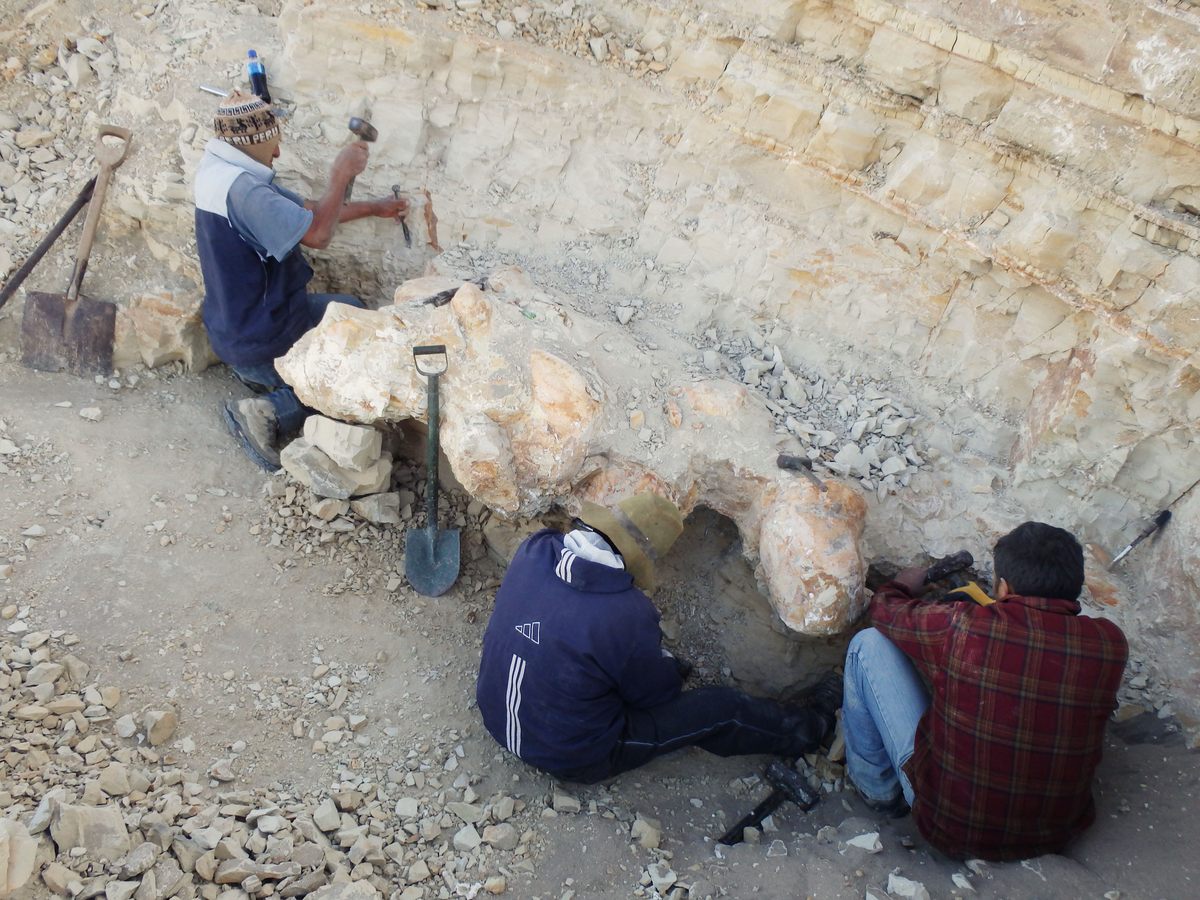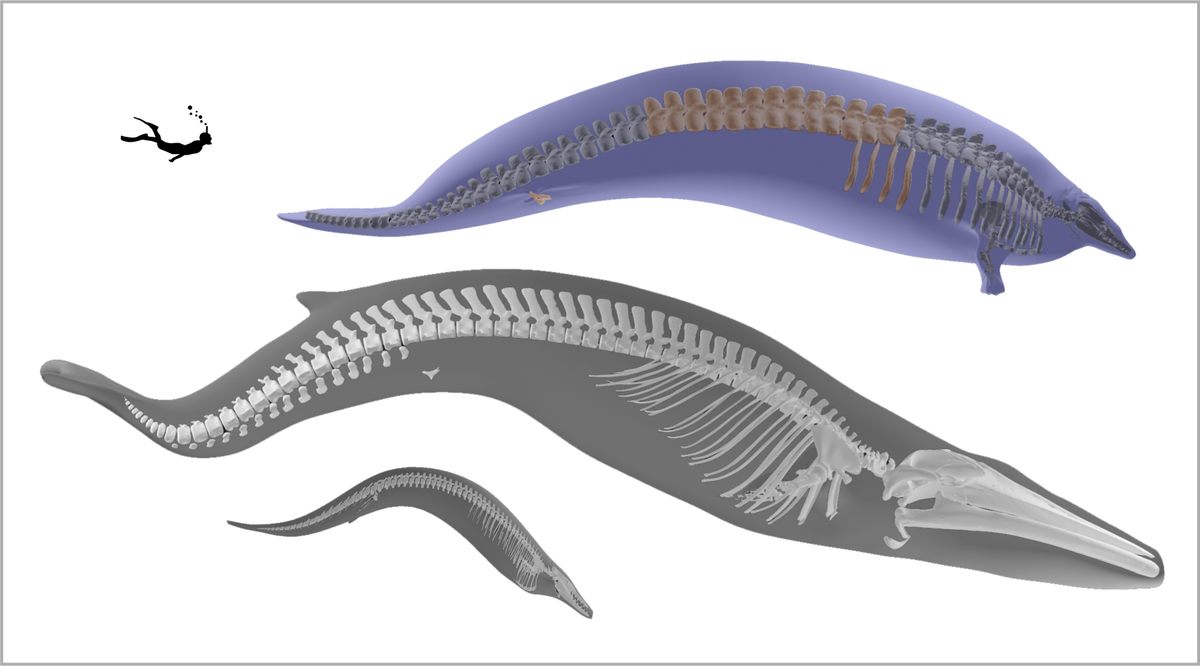Paleontologists in Peru Discover What Might Be the ‘Chonkiest Whale Ever’
And maybe the heaviest animal the world has ever seen.
Thirteen years ago, paleontologist Mario Urbina made a remarkable discovery in the coastal desert of Peru. He had a hunch that it was something really special. But his conclusion was so odd that it took years of excavation and testing to show international scientists that his convictions were right, according to Urbina’s field partner and fellow paleontologist Rodolfo Salas-Gismondi, head of the vertebrate paleontology department at the Museum of Natural History in Lima. They were fossil masses, and what Urbina thought they were: preserved bones from a new species of early whale, dating to 39 million years ago. And, it turns out, this one was a whopper.
“The authors have definitely found something new. This is a really weird, stupendously large, early whale,” says paleobiologist Nicholas Pyenson, the curator of fossil marine mammals at the Smithsonian National Museum of Natural History.
This whale relative, named Perucetus colossus—“the colossal whale from Peru”—is pretty darn big. In their new study published today in Nature, the international team of researchers posit that it could be the heaviest animal. Ever. By their estimates, the species would have had a 65-foot skeleton that outweighs the 82-foot skeleton of a blue whale—the world’s current heavyweight champion species—by two to three times, possibly resulting in an overall body weight of between 90 and 370 tons. At the upper range, that’s more than twice as chonky as a blue whale. Further, this ancient giant falls far earlier in history than scientists would expect, changing the known evolutionary timeline for huge whales up by 30 million years.
“Besides the Guinness Book aspect of it, from a scientific perspective, the most important part is the understanding of what conditions can yield extreme gigantism,” says coauthor Eli Amson, of the State Museum of Natural History in Stuttgart, Germany. “This changes a lot of our understanding of gigantism and basically provides another evolutionary path to it.”

P. colossus is one of the earliest whales that fully transitioned from land to water in the middle Eocene, about 40 million years ago. More than its overall size, the bones of this species are extremely dense. It has an extra layer of bone on the outer surface of the skeleton (pachyostosis), and the inner cavities are filled with compact bone (osteosclerosis). These dense features are seen in other shallow-water animals, such as manatees, and allow them to control their buoyancy. In contrast, today’s biggest whales have lighter bones, which are better suited for deep diving.
Prior to this discovery, gigantism in whales—think marine leviathans such as blue whales and sperm whales—was considered a relatively recent event, evolutionarily speaking: about five million years ago. Also, today’s biggest whales evolved in open seas, but this new species evolved to be just huge far earlier, rather quickly, in shallow coastal waters. “We were really not expecting the coastal environment to be able to sustain such a massive animal,” says Amson.
The preserved bones have taken over a decade to excavate from a 100-foot hill. Each field campaign could only transport two of the massive vertebrae, says Salas-Gismondi; at the end of 13 years of work, 13 have been recovered, each 220 pounds, along with four ribs, each over four feet long, and a hip bone.
“I think what the authors are proposing is perhaps the chonkiest whale ever,” says Pyenson, from the Smithsonian. “But I’m not really sure that we can reliably say much about that. It’s certainly weird. It certainly is really big. Is it larger than a blue whale? I don’t think we have enough of a skeleton to definitively say that.”

The skeleton is partial—missing the skull, in particular—so Pyenson is more confident about estimating length than weight. “Length estimates are more reliably reconstructed from incomplete material,” he says. “What is much harder is weight. I am skeptical of some of the larger size estimates because they place it in a body size category for which we have no comparison.”
How, he wonders, could a 300-ton mammal sustain itself? He isn’t particularly convinced by any of the authors’ suggestions, from a vegetarian diet to filter feeding to scavenging sunken carcasses. “Blue whales living today are already in the 150-ton category, living at a perilous edge of barely being able to maintain their large body size,” says Pyenson.
“I think we are going to continue to look for the head,” says Salas-Gismondi, “because without the head we don’t know anything about the feeding strategies, the diet, nothing. That’s an important part of reconstruction.”
Regardless of superlatives, the findings add to researchers’ understanding of evolution, which can help us look toward the future, says Pyenson. “I think charting that and trying to understand those details is worth the effort,” he says. “The world [today] is changing at geologic scale and rates. Understanding the fate of how all organisms respond to climate change at this kind of great magnitude, that’s a kind of question we can answer in part with data from the fossil record—it’s not the only source of data, but it’s really important.”

The skeletal fragments are currently on display at the Museum of Natural History in Lima. Urbina, Salas-Gismondi, and their colleagues are continuing to explore the unique and bountiful fossil beds of Peru to raise funds for a new lab and inspire young Peruvians to pursue paleontology.
“In the past, Peruvian fossils were only studied by foreign institutions,” says Salas-Gismondi. “Now, we still have a small team, but it is becoming larger and more competitive. In the future, maybe we can be the first authority in these kinds of publications.”




















Follow us on Twitter to get the latest on the world's hidden wonders.
Like us on Facebook to get the latest on the world's hidden wonders.
Follow us on Twitter Like us on Facebook